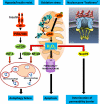What old means to bone
- PMID: 20223679
- PMCID: PMC2880220
- DOI: 10.1016/j.tem.2010.01.010
What old means to bone
Abstract
The adverse effects of aging of other organs (ovaries at menopause) on the skeleton are well known, but ironically little is known of skeletal aging itself. Evidence indicates that age-related changes, such as oxidative stress, are fundamental mechanisms of the decline of bone mass and strength. Unlike the short-lived osteoclasts and osteoblasts, osteocytes--former osteoblasts entombed in the mineralized matrix--live as long as 50 years, and their death is dependent on skeletal age. Osteocyte death is a major contributor to the decline of bone strength with age, and the likely mechanisms are oxidative stress, autophagy failure and nuclear pore "leakiness". Unraveling these mechanisms should improve understanding of the age-related increase in fractures and suggest novel targets for its prevention.
Published by Elsevier Ltd.
Figures


References
-
- Manolagas SC. Birth and death of bone cells: basic regulatory mechanisms and implications for the pathogenesis and treatment of osteoporosis. Endocr. Rev. 2000;21:115–137. - PubMed
-
- Riggs BL, et al. Sex steroids and the construction and conservation of the adult skeleton. Endocr. Rev. 2002;23:279–302. - PubMed
-
- Manolagas SC, Almeida M. Gone with the Wnts: beta-catenin, T-cell factor, forkhead box O, and oxidative stress in age-dependent diseases of bone, lipid, and glucose metabolism. Mol. Endocrinol. 2007;21:2605–2614. - PubMed
Publication types
MeSH terms
Grants and funding
LinkOut - more resources
Full Text Sources
Medical

